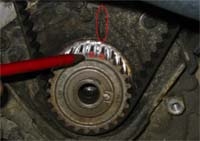
click to enlarge
M O D I F I C A T I O N S : ENGINE - timing
When fiddling with the engine and all the parts directly connected to the engine, knowing something about timing is essential. The last thing you want is an exhaust valve going down, while there is still an inlet valve completely opened and the piston is reaching its most upper position. A perfect timing between inlet valves (or camshaft), exhaust valves (or camshaft) and crankshaft is needed for a good working engine with some nice power figures.
Seeting up a perfect timing is not possible using the standard parts, but the timing can be set correctly just like it was done during the production of the car. For most of the cars, this is sufficient.
At the lowest point of the cambelt, after removing the rear wheel (righthand side of car), removing some dull isolation in the wheelarch, removing the plastic cover, removing the pulley; the crankshaft pulley can be seen. On the iron casting of the engine there is a long marking. On the pully itself, you will find two dots. Align the two dots with the marrking on the engine.
On each pully of a camshaft a marking is visible. When the crankshaft is positioned in its maintenance point (see above), the two markings on the pulley's need to point to each other. If they are pointing the oposite way, cicle the cranshaft one turn (in the same time frame the crankshaft turns 2 times while each camshaft turns 1 time). The picture below shows the two pulley (not in place anymore), the red plastic locking tool and the two markings pointing to each other.